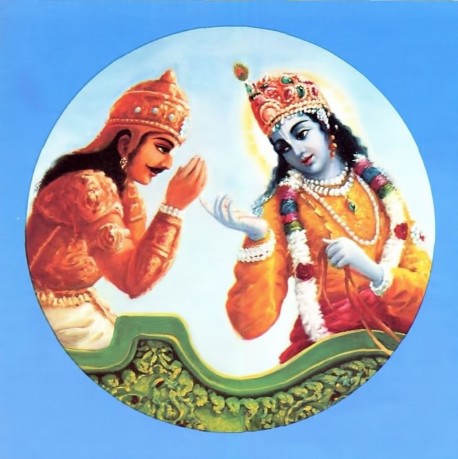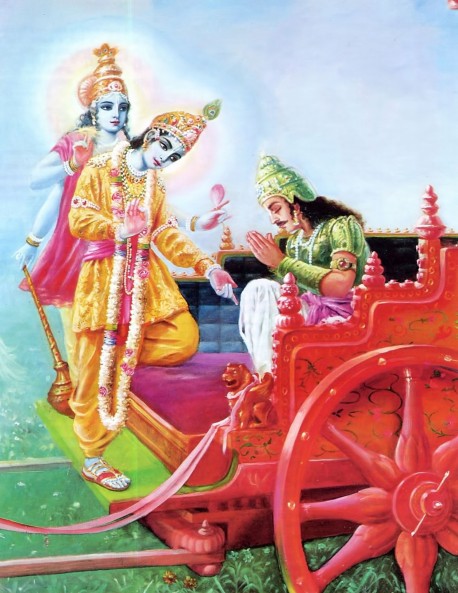Krishna consciousness is the natural occupational duty of the spiritual soul. Religions, sects, denominations and faiths exist on the mental and intellectual platforms, but every creature, from demigods down to insects, has a true spiritual identity as a loving devotee of Lord Krishna.
by His Holiness Acyutananda Svami
His Holiness Acyutananda Svami, an American devotee in the renounced order of life, has been actively preaching Krishna consciousness in northern India for the last five years. He is the editor of a book of Krishna conscious songs written by great spiritual masters, soon to be published by the Bhaktivedanta Book Trust.
WHEN WE SPEAK OF a Krishna conscious devotee, we do not refer to a person born in a family of devotees or someone wearing two white lines on his forehead. Since “Krishna” refers to the Supreme Lord, every living creature is naturally a Krishna conscious devotee. Because our false egos cover our Krishna consciousness, however, we think that we are Christians, Hindus, Indians, Americans or Russians, or that we are tall, short, brown, white and so on.
We should understand the term “Krishna conscious devotee” to be identical to the word jiva, “soul.”
jivera ‘svarupa’ haya—krsnera ‘nitya-dasa’
krsnera ‘tatastha-sakti,’ ‘bhedabheda-prakasa’
(Caitanya-caritamrta, Madhya 20.108)
The real nature of the living entity is to be the eternal servant of Krishna. The living entities constitute the marginal potency of the Lord, which although different from Him is not different from Him. In his true form, the soul is a person, a person who has a romantic relationship with Krishna. When purified of material illusion’s limitations, this loving energy will bloom in our consciousness, if it does not, this indicates imperfect realization.
Bhagavad-gita and all Vedic literatures clearly establish these points, but we always meet people who get the whole message backwards. To understand why they do is not easy, for the scriptures themselves explain the process of knowing the Lord: loving devotion alone. The Gita’s verses affirm repeatedly that only through devotion, not merely by studying speculative doctrines or contemplating a formless void, can one attain perfection. Krishna reveals to Arjuna the gita-rahasya, or secret of the Gita, not because Arjuna is a yogi, Vedantic scholar or monk, for he is not. Arjuna is a worldly householder, soldier and politician. What, then, qualifies him to receive the Gita’s secret? What is it in Arjuna that draws from Sri Krishna the secret of the Gita? Lord Krishna tells Arjuna, bhakto ‘si me sakha ceti rahasyam hy etad uttamam: “Because you are My devotee and intimate friend, I reveal this secret to you.” (Bg. 4.3) As a label’s instructions explain how to take a medicine, so this verse explains the process for understanding the Gita: one should simply become a friend and devotee of Krishna, and He will then reveal everything.
After Sri Krishna thoroughly explains hatha-yoga and meditation, Arjuna refuses to follow these processes. “My mind is too unstable to control,” he says. “It would be easier to control the wind.” Does Lord Krishna then chastise Arjuna for being a cowardly disciple and not taking up such yoga? Does He encourage Arjuna in any way to follow the hatha-yoga path? No. He tells Arjuna, “Of all yogis, he who worships Me with faith and devotion I consider the best.” (Bg. 6.47) In the Third Chapter the Lord discusses karma-yoga and then jnana and hatha, but of all yogi’s, Krishna considers the devotee supreme.
In the Eighth Chapter Krishna says that one can reach the Supreme Lord only by bhakti: bhaktya labhyas tv ananyaya (Bg. 8.22). Ananyaya means “in no other way.” This Eighth Chapter abounds with verses directing us to accept the path of devotion rather than any other. In the seventh verse Krishna urges us, “Always think of Me and at the same time carry out your duty with your activities dedicated to Me and your mind and intelligence fixed upon Me.” Again in the fourteenth verse, the Lord stresses the same exclusive devotion. “For one who remembers Me unflinchingly, and who constantly engages in devotional service, I am easy to obtain.”
In the Ninth Chapter the Lord describes the specific character of a mahatma, a broad-minded great soul, as being that of a devotee. Beginning with the thirteenth verse, the Lord extolls bhakti, emphasizing again that it is ananya, the only path:
mahatmanas tu mam partha
daivim prakrtim asritah
bhajanty ananya-manaso
jnatva bhutadim avyayam
O son of Prtha, those who are not deluded, the great souls (mahatmas), are under the protection of the divine nature. They fully engage in devotional service because they know Me as the Supreme Personality of Godhead, original and inexhaustible. (Bg. 9.13) The term ananya indicates that no other way is at all acceptable. What are the characteristics of these mahatmas?

satatam kirtayanto mam
yatantas ca drdha-vratah
namasyantas ca mam bhaktya
nitya-yukta upasate
“Always chanting My glories, endeavoring with great determination, bowing down before Me, these great souls perpetually worship Me with devotion.” (Bg. 9.14)
The Lord then lists nondevotional practices performed by anye, “others.” Who are these others? Since the mahatmas glorify and worship Krishna, those who cultivate speculative knowledge, meditate upon the universal form, or worship the abstract one, diverse in many, are not mahatmas but merely “others.”
The famous twenty-second verse assures devotees that if they reject all other engagements and single-mindedly concentrate upon Krishna, they need not bother for their personal needs, for the Lord says, “I personally maintain one who engages in My service.” Special words in verses twenty and twenty-one also note that the heavenly planets are not the ultimate goal and that one should not worship as equal to Krishna the demigods who preside there. Many common readers of the Gita think that all gods are equal and that it therefore does not matter whom one chooses as his ista-deva (worshipable deity). But in verse twenty-five the Lord says otherwise. Yanti mad-yajino ‘pi mam: Other devotees achieve other destinations, “but only those who worship Me will live with Me.” And how should one worship the Lord?
patram puspam phalam toyam yo me bhaktya prayacchati
One may worship Him even by offering only “a leaf, a flower, fruit or water, with love and devotion.” (Bg. 9.26) Certainly it is not the value of the leaf, flower or fruit that attracts the mercy of the Lord; it is the bhakti, love. This bhakti should enter every aspect of one’s life, for the Lord says:
yat karosi yad asnasi
yaj juhosi dadasi yat
yat tapasyasi kaunteya
tat kurusva mad-arpanam
“All that you do, all that you eat, all that you offer and give away, as well as all austerities that you may perform, should be done as an offering unto Me.” (Bg. 9.27)
The Ninth Chapter ends by describing bhakti’s astounding purificatory quality of being able to turn sudras into saints. The Lord declares, na me bhaktah pranasyati: “My devotee will never perish.” (Bg. 9.31) In the final verse, whose words are again repeated in the Eighteenth Chapter, the Lord enjoins:
man-mana bhava mad-bhakto
mad-yaji mam namaskuru
mam evaisyasi yuktvaivam
atmanam mat-parayanah
“Engage your mind always in thinking of Me, offer obeisances and worship Me. Being completely absorbed in Me, surely you will come to Me.” (Bg. 9.34)
Lord Krishna does not have much time to talk to Arjuna, for the battle cries have already been heralded. He teaches Arjuna in the most concise words. Therefore anything the Lord repeats is most significant.
The Tenth Chapter contains four of the strongest verses stressing the importance of bhakti (verses 8-11).
aham sarvasya prabhavo
mattah sarvam pravartate
iti matva bhajante mam
budha bhava-samanvitah
“I am the source of all spiritual and material worlds. Everything emanates from Me. The wise who perfectly know this engage in My devotional service and worship Me with all their hearts.” (Bg. 10.8)

mac-citta mad-gata-prana
bodhayantah parasparam
kathayantas ca mam nityam
tusyanti ca ramanti ca
How do devotees behave? What always engages their minds? “The thoughts of My pure devotees dwell in Me, their lives are surrendered to Me, and they derive great satisfaction and bliss enlightening one another and conversing about Me.” (Bg. 10.9)
Then:
tesam satata-yuktanam
bhajatam priti-purvakam
dadami buddhi-yogam tam
yena mam upayanti te
“To those who are constantly devoted and worship Me with love, I give the understanding by which they can come to Me.” (Bg. 10.10)
And finally:
tesam evanukampartham
aham ajnana-jam tamah
nasayamy atma-bhava-stho
jnana-dipena bhasvata
“Out of compassion for them, I, dwelling in their hearts, destroy with the shining lamp of knowledge the darkness born of ignorance.” (Bg. 10.11)
An intimate friend always knows deeper truths about someone than those who gather information from outsiders. Indeed, no one can say more about you than you yourself. Similarly, no one can tell more about Krishna than Krishna Himself, and He chooses to reveal such knowledge to His intimate devotees.
After revealing the universal form to Arjuna, Krishna shows His four-armed form and then His humanlike two-armed form and says:
naham vedair na tapasa
na danena na cejyaya
sakya evam-vidho drastum
drstavan asi mam yatha
“This form which you are seeing with your transcendental eyes cannot be understood simply by studying the Vedas, nor by undergoing serious penances, nor by charity, nor by worship. It is not by these means that you can see Me as I am.” (Bg. 11.53)
How is it, then, that Arjuna can see the transcendental form of the Lord? The next verse echoes the answer given in the previous chapters:
bhaktya tv ananyaya sakya
aham evam-vidho ‘rjuna
jnatum drastum ca tattvena
pravestum ca parantapa
“My dear Arjuna, only by undivided devotional service can I be understood as I am, standing before you, and can thus be seen directly. Only in this way can you enter into the mysteries of My understanding.” (Bg. 11.54) The Brahma-samhita mentions this same point. Vedesu durlabham adurlabham atma-bhaktau: “The Lord is rarely known through Vedic study but easily known through self-surrender.” (Bs. 5.33)
The Twelfth Chapter is entirely devoted to steering us away from the difficult path of impersonalism. Arjuna puts the question clearly: “Which yogi do you consider the higher-the one who contemplates Your formless aspect or the devotee who worships Your form?” Lord Krishna’s answer is just as direct and clear as the question:
sri-bhagavan uvaca
mayy avesya mano ye mam
nitya-yukta upasate
sraddhaya parayopetas
te me yuktatama matah
“The Blessed Lord said: He whose mind is fixed on My personal form, always engaged in worshiping Me with great and transcendental faith, is considered by Me to be the most perfect.” (Bg. 12.2)
In the fifth verse the Lord totally discourages mental speculation on formless, attributeless Brahman, and, in the chapter’s remaining fifteen verses, He totally supports bhakti-yoga.
The following chapters of the Gita give an analytical description of Lord Krishna, His supremacy over the material modes of nature, and His presence as the Supersoul and the Supreme Personality of Godhead. The conclusion of the Fifteenth Chapter is bhakti:
yo mam evam asammudho
janati purusottamam
sa sarva-vid bhajati mam
sarva-bhavena bharata
“Whoever knows Me as the Supreme Personality of Godhead, without doubting, is to be understood as the knower of everything, and he therefore engages himself in full devotional service, O son of Bharata.” (Bg. 15.19)
The conclusion of the Eighteenth Chapter, the Gita’s last, and therefore the conclusion of the entire Gita, says, bhaktya mam abhijanati: “Through devotion am I to be known.” (Bg. 18.55) And the repetition of man-mana bhava mad bhakto (“Thinking of Me, become My devotee”) leads us to the Gita’s final statement—sarva-dharman parityajya mam ekam saranam vraja: “Abandon all varieties of religion and just surrender unto Me.” (Bg. 18.66) There is no room for challenging or misunderstanding these statements.
The purpose for the above summary of the Gita is to reveal over forty-five verses exclusively supporting the path of bhakti.
“To Me” Means To Krishna
Mam, mad, asmi, man, mama and aham (all forms of the words “I,” “Me,” and “I am”) when spoken by Krishna Himself refer to Krishna Himself. Any other interpretation simply hides Krishna and His real identity. By trying to interpret the name Krishna to mean “black,” “dark,” “unknown” and so on, nondevotees simply want to say that Krishna is not a worshipable person, but something with no personality and therefore not worshipable. This point breeds complete rejection of true bhakti, and a complete misunderstanding of the Gita. Since love must be exchanged between two persons—the lover and the beloved—an impersonal, abstract, formless objective cancels the possibility of devotion. But the Gita, in the above forty-five verses, emphatically declares that bhakti is the way-and ananya, the only way.
One should not waste time trying to concoct twisted interpretations of Vedic statements. For example, hari om tat sat means that Hari, Krishna, is the Absolute Truth. Now, Hari can mean “snake,” “thief,” “lion” or”Krishna.” But are we to understand that the Absolute Truth is a snake? A lion? A thief? Are we to build temples to snakes, lions and thieves? Of course not. Therefore, one must understand the word hari from the definition of the scriptures. The Absolute Truth is Krishna. One cannot expect to fix one’s mind and intelligence on snakes, lions or thieves and surrender everything to them, nor can one surrender one’s services and the fruits of all activities to “the dark,” “the black,” or “the unknown.” How can there be love if there is no knowledge of the beloved? The recipient of bhakti must be a person, and that person must be the Supreme Absolute Truth, if one considers Krishna less than the impersonal Absolute, one does not understand Krishna. One’s show of devotion is then only symbolic and therefore useless. Real love is not symbolic; it comes from the spiritual platform:
brahma-bhutah prasannatma
na socati na kanksati
samah sarvesu bhutesu
mad-bhaktim labhate param
“After fully realizing his spiritual identity, one does not hanker for any attainment nor lament for any loss. Seeing all beings with an equal eye, the soul develops supreme devotion.” (Bg. 18.54)
Bhakti exists even after mukti, liberation. A devotee will never allow anything to obstruct the soul’s passionate love for the Lord, and therefore although other yogis forget their personal independence when they approach liberation, a devotee does not. He continues his devotion beyond liberation. That is real love. Not that one loves Krishna until one achieves liberation, and then love ends. No. Love for Krishna is sanatana, eternal.
The Gita mentions three truths as sanatana: Lord Krishna is sanatana, the transcendental realm is sanatana, and the living being is sanatana. The joining of these three is called sanatana-dharma, or the eternal engagement, and that is bhakti, devotional service.
People often think that the ultimate is a formless spirit and that from that spirit pour Krishna, Visnu, Siva and thirty-three million other demigods. At the ultimate end, they think, all will merge again into voidness. But the Gita states just the opposite. The Lord says, aham sarvasya prabhavah: “I am the source of all.” (Bg. 10.8) Furthermore, aham krtsnasya jagatah prabhavah pralayas tatha: “I am the creator and destroyer of this entire universe.” (Bg. 7.6) These statements prove that Krishna is the Absolute Truth. But is the Lord referring to His void aspect or His personal aspect? The answer is very strong:
avyaktam vyaktim apannam
manyante mam abuddhayah
param bhavam ajananto
mamavyayam anuttamam
“Unintelligent men, who know Me not, think that I have assumed this form and personality. Due to their small knowledge, they do not know My higher nature, which is changeless and supreme.” (Bg. 7.24) Krishna’s form does not change, evaporate, dissolve or merge into nonexistence, for it is not a material body. Krishna’s pastimes are going on eternally, unobstructed by the creation, maintenance and destruction of this world. His form is not material; it is sac-cid-ananda-vigraha, an embodiment of eternity, knowledge and bliss. That such a form of spiritual qualities exists beyond the three modes of nature is inconceivable to a mind overpowered by these modes, but it is completely clear to the minds of His devotees, for by bhakti and no other way can one understand the Lord. The Lord says, brahmano hi pratisthaham:
“I am the basis of Brahman [the impersonal Absolute].” (Bg. 14.27) The impersonal Absolute (Brahman) is subordinate to the Lord’s personal feature (Bhagavan), just as sunlight is subordinate to the sun.
The scriptures are like a grand algebraic equation. One side of the equation describes the Absolute’s qualities but does not give His identity. For example, raso vai sah: “He, the Absolute, is the source of all loving tastes [rasas].” This gives the idea of a person but keeps His identity hidden. In algebra the equation would look like this:
x= the source of rasa
The four Vedas, the Puranas, the Upanisads, the Mahabharata and the Vedanta-sutra give the left side of the equation, and Srimad-Bhagavatam, on the right, gives the identity of x. Krishnas caitanya-rasa-vigrahah: “Krishna is the embodiment of all rasas.” Therefore, x= Krishna. Who is the Supreme Lord? Who is the Absolute Truth? Whenever the scriptures speak of the Supreme, the Lord, or the Absolute, if we understand Krishna, the speaker of Bhagavad-gita, to be this unknown Supreme Person, our knowledge is perfect and complete.


Leave a Reply